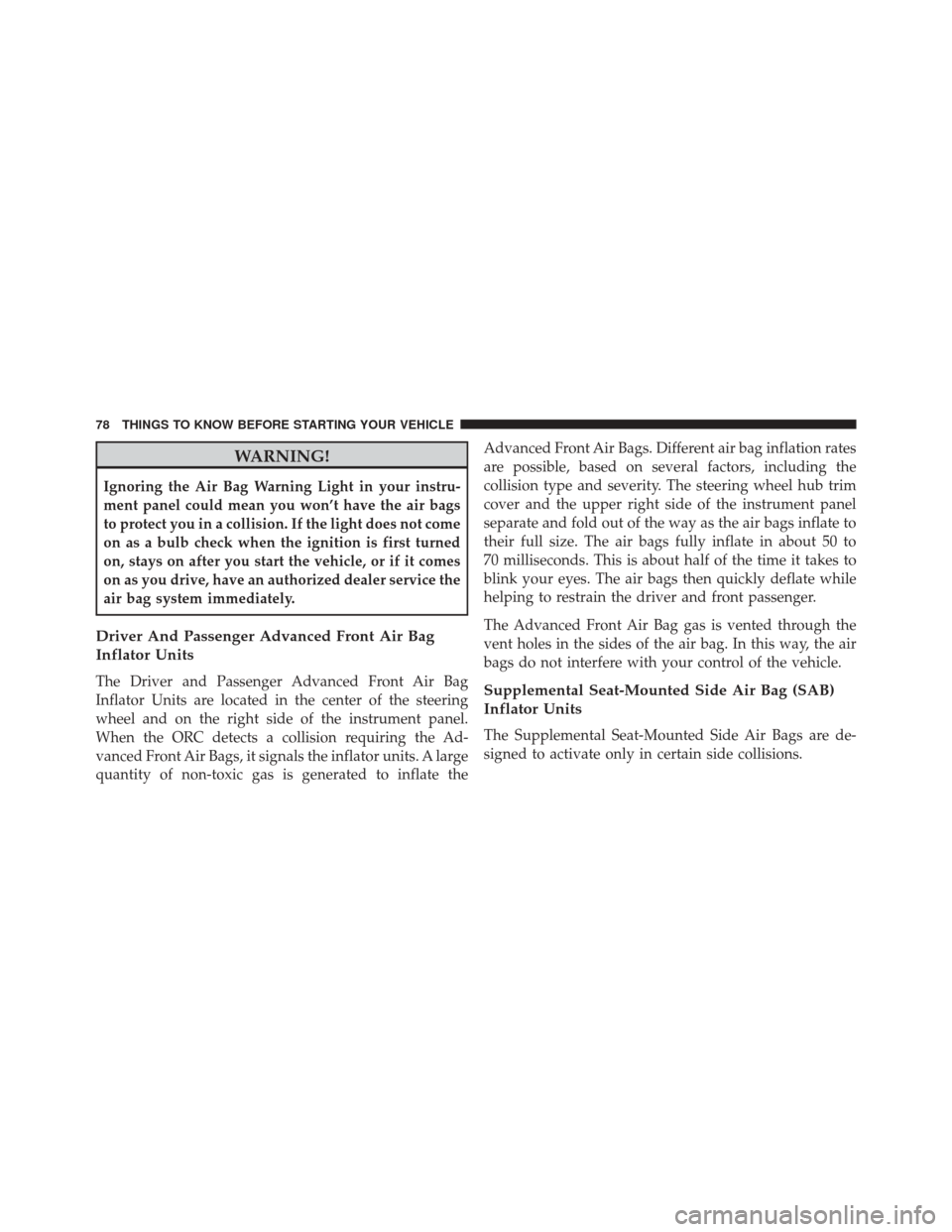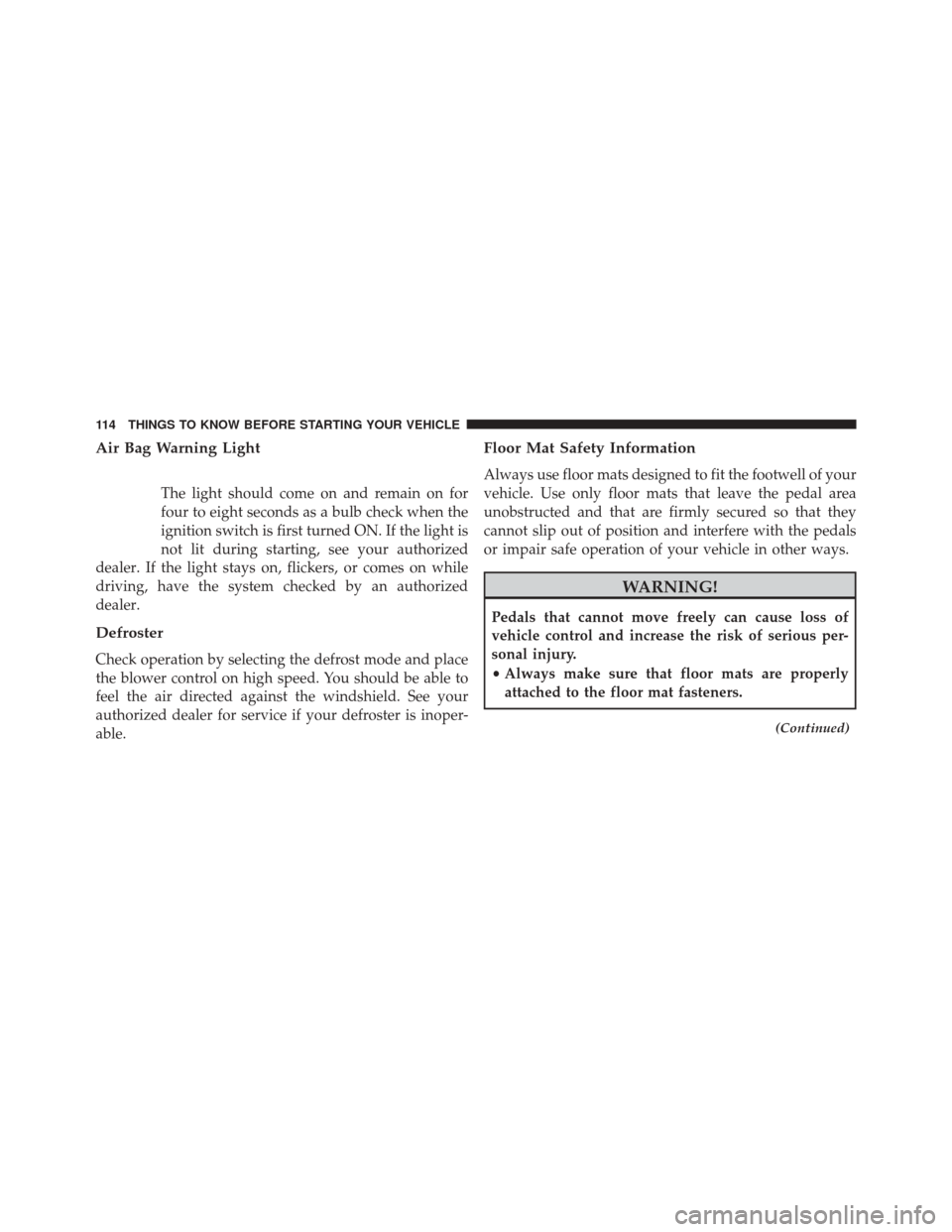Page 79 of 615

Because air bag sensors measure vehicle deceleration
over time, vehicle speed and damage by themselves are
not good indicators of whether or not an air bag should
have deployed.
Seat belts are necessary for your protection in all colli-
sions, and also are needed to help keep you in position,
away from an inflating air bag.
The ORC monitors the readiness of the electronic parts of
the air bag system whenever the ignition switch is in the
START or ON/RUN position. If the key is in the OFF
position, in the ACC position, or not in the ignition, the
air bag system is not on and the air bags will not inflate.
The ORC contains a backup power supply system that
may deploy the air bags even if the battery loses power or
it becomes disconnected prior to deployment.Also, the ORC turns on the Air Bag Warning
Light in the instrument panel for approxi-
mately four to eight seconds for a self-check
when the ignition is first turned on. After the
self-check, the Air Bag Warning Light will turn off. If the
ORC detects a malfunction in any part of the system, it
turns on the Air Bag Warning Light, either momentarily
or continuously. A single chime will sound if the light
comes on again after initial startup.
It also includes diagnostics that will illuminate the instru-
ment cluster Air Bag Warning Light if a malfunction is
noted that could affect the air bag system. The diagnos-
tics also record the nature of the malfunction.
2
THINGS TO KNOW BEFORE STARTING YOUR VEHICLE 77
Page 80 of 615

WARNING!
Ignoring the Air Bag Warning Light in your instru-
ment panel could mean you won’t have the air bags
to protect you in a collision. If the light does not come
on as a bulb check when the ignition is first turned
on, stays on after you start the vehicle, or if it comes
on as you drive, have an authorized dealer service the
air bag system immediately.
Driver And Passenger Advanced Front Air Bag
Inflator Units
The Driver and Passenger Advanced Front Air Bag
Inflator Units are located in the center of the steering
wheel and on the right side of the instrument panel.
When the ORC detects a collision requiring the Ad-
vanced Front Air Bags, it signals the inflator units. A large
quantity of non-toxic gas is generated to inflate theAdvanced Front Air Bags. Different air bag inflation rates
are possible, based on several factors, including the
collision type and severity. The steering wheel hub trim
cover and the upper right side of the instrument panel
separate and fold out of the way as the air bags inflate to
their full size. The air bags fully inflate in about 50 to
70 milliseconds. This is about half of the time it takes to
blink your eyes. The air bags then quickly deflate while
helping to restrain the driver and front passenger.
The Advanced Front Air Bag gas is vented through the
vent holes in the sides of the air bag. In this way, the air
bags do not interfere with your control of the vehicle.Supplemental Seat-Mounted Side Air Bag (SAB)
Inflator Units
The Supplemental Seat-Mounted Side Air Bags are de-
signed to activate only in certain side collisions.
78 THINGS TO KNOW BEFORE STARTING YOUR VEHICLE
Page 82 of 615

enough force to injure you if you are not belted and
seated properly, or if items are positioned in the area
where the SABIC inflates. This especially applies to
children. The SABIC is only about 3-1/2 in (9 cm) thick
when it is inflated.
Because air bag sensors estimate deceleration over time,
vehicle speed and damage are not good indicators of
whether or not an air bag should have deployed.
NOTE:In a rollover the pretensioners and/or SAB and
SABIC air bags, and driver/passenger knee air bags may
deploy on both sides of the vehicle.
Front And Side Impact Sensors
In front and side impacts, impact sensors can aid the
ORC in determining appropriate response to impact
events.
Enhanced Accident Response System
In the event of an impact causing air bag deployment, if
the communication network remains intact, and the
power remains intact, depending on the nature of the
event the ORC will determine whether to have the
Enhanced Accident Response System perform the follow-
ing functions:
• Cut off fuel to the engine.
• Flash hazard lights as long as the battery has power or
until the ignition key is turned off.
• Turn on the interior lights, which remain on as long as
the battery has power or until the ignition key is
removed.
• Unlock the doors automatically.
80 THINGS TO KNOW BEFORE STARTING YOUR VEHICLE
Page 85 of 615

WARNING!(Continued)
•Do not attempt to modify any part of your air bag
system. The air bag may inflate accidentally or may
not function properly if modifications are made.
Take your vehicle to an authorized dealer for any
air bag system service. If your seat, including your
trim cover and cushion, needs to be serviced in any
way (including removal or loosening/tightening of
seat attachment bolts), take the vehicle to your
authorized dealer. Only manufacturer approved
seat accessories may be used. If it is necessary to
modify the air bag system for persons with dis-
abilities, contact your authorized dealer.
Air Bag Warning Light
You will want to have the air bags ready to
inflate for your protection in a collision. The
Air Bag Warning Light monitors the internal
circuits and interconnecting wiring associated
with air bag system electrical components. While the air
bag system is designed to be maintenance free. If any of
the following occurs, have an authorized dealer service
the air bag system immediately.
• The Air Bag Warning Light does not come on during
the four to eight seconds when the ignition is first
cycled to the ON/RUN.
• The Air Bag Warning Light remains on after the four to
eight-second interval.
• The Air Bag Warning Light comes on intermittently or
remains on while driving.
2
THINGS TO KNOW BEFORE STARTING YOUR VEHICLE 83
Page 116 of 615

Air Bag Warning Light
The light should come on and remain on for
four to eight seconds as a bulb check when the
ignition switch is first turned ON. If the light is
not lit during starting, see your authorized
dealer. If the light stays on, flickers, or comes on while
driving, have the system checked by an authorized
dealer.
Defroster
Check operation by selecting the defrost mode and place
the blower control on high speed. You should be able to
feel the air directed against the windshield. See your
authorized dealer for service if your defroster is inoper-
able.
Floor Mat Safety Information
Always use floor mats designed to fit the footwell of your
vehicle. Use only floor mats that leave the pedal area
unobstructed and that are firmly secured so that they
cannot slip out of position and interfere with the pedals
or impair safe operation of your vehicle in other ways.
WARNING!
Pedals that cannot move freely can cause loss of
vehicle control and increase the risk of serious per-
sonal injury.
• Always make sure that floor mats are properly
attached to the floor mat fasteners.
(Continued)
114 THINGS TO KNOW BEFORE STARTING YOUR VEHICLE
Page 118 of 615

Periodic Safety Checks You Should Make Outside
The Vehicle
Tires
Examine tires for excessive tread wear and uneven wear
patterns. Check for stones, nails, glass, or other objects
lodged in the tread or sidewall. Inspect the tread for cuts
and cracks. Inspect sidewalls for cuts, cracks and bulges.
Check the wheel nuts for tightness. Check the tires
(including spare) for proper cold inflation pressure.
Lights
Have someone observe the operation of brake lights and
exterior lights while you work the controls. Check turn
signal and high beam indicator lights on the instrument
panel.
Door Latches
Check for positive closing, latching, and locking.
Fluid Leaks
Check area under vehicle after overnight parking for fuel,
engine coolant, oil, or other fluid leaks. Also, if gasoline
fumes are detected or if fuel, power steering fluid (if
equipped), or brake fluid leaks are suspected, the cause
should be located and corrected immediately.
116 THINGS TO KNOW BEFORE STARTING YOUR VEHICLE
Page 120 of 615

▫General Information ....................145
� SEATS ............................. .145
▫ Power Seats — If Equipped ..............146
▫ Passenger’s Power Seat .................148
▫ Power Lumbar — If Equipped ............149
▫ Manual Front Seats Forward/Rearward
Adjustment ........................ .150
▫ Manual Front Passenger Seatback Adjustment —
Recline ........................... .151
▫ Front Passenger Seat Fold-Flat Feature —
If Equipped ......................... .152
▫ Heated Seats — If Equipped ..............152
▫ Front Ventilated Seats With Uconnect®
8.4A/8.4AN — If Equipped ..............156▫
Head Restraints ...................... .158
▫ 60/40 Split Rear Seat ..................162
▫ Reclining Rear Seat ....................164
� DRIVER MEMORY SEAT — IF EQUIPPED . . . .164
▫ Programming The Memory Feature .........166
▫ Linking And Unlinking The Remote Keyless
Entry Transmitter To Memory .............167
▫ Memory Position Recall .................168
▫ Easy Entry/Exit Seat ...................169
� TO OPEN AND CLOSE THE HOOD .........170
� LIGHTS ............................ .171
▫ Headlight Switch .....................171
▫ Automatic Headlights — If Equipped .......172
118 UNDERSTANDING THE FEATURES OF YOUR VEHICLE
Page 121 of 615

▫Headlights On Automatically With Wipers . . .173
▫ Automatic High Beam — If Equipped ......173
▫ Daytime Running Lights — If Equipped .....175
▫ Automatic Headlight Leveling —
HID Headlights Only ...................175
▫ Adaptive Bi-Xenon High Intensity Discharge
Headlights — If Equipped ...............175
▫ Headlight Delay ..................... .176
▫ Parking Lights And Panel Lights ...........176
▫ Fog Lights — If Equipped ...............176
▫ Interior Lights ....................... .177
▫ Lights-On Reminder ...................178
▫ Battery Saver ........................ .178
▫ Front Map/Reading Lights ..............179▫
Courtesy Lights ...................... .180
▫ Ambient Light ....................... .180
▫ Multifunction Lever ....................181
▫ Turn Signals ........................ .181
▫ Lane Change Assist ...................181
▫ Flash-To-Pass ....................... .182
▫ High/Low Beam Switch .................182
� WINDSHIELD WIPERS AND WASHERS ......182
▫ Windshield Wiper Operation .............183
▫ Intermittent Wiper System ...............183
▫ Windshield Washer Operation .............184
▫ Mist .............................. .185
▫ Rain Sensing Wipers — If Equipped ........186
3
UNDERSTANDING THE FEATURES OF YOUR VEHICLE 119